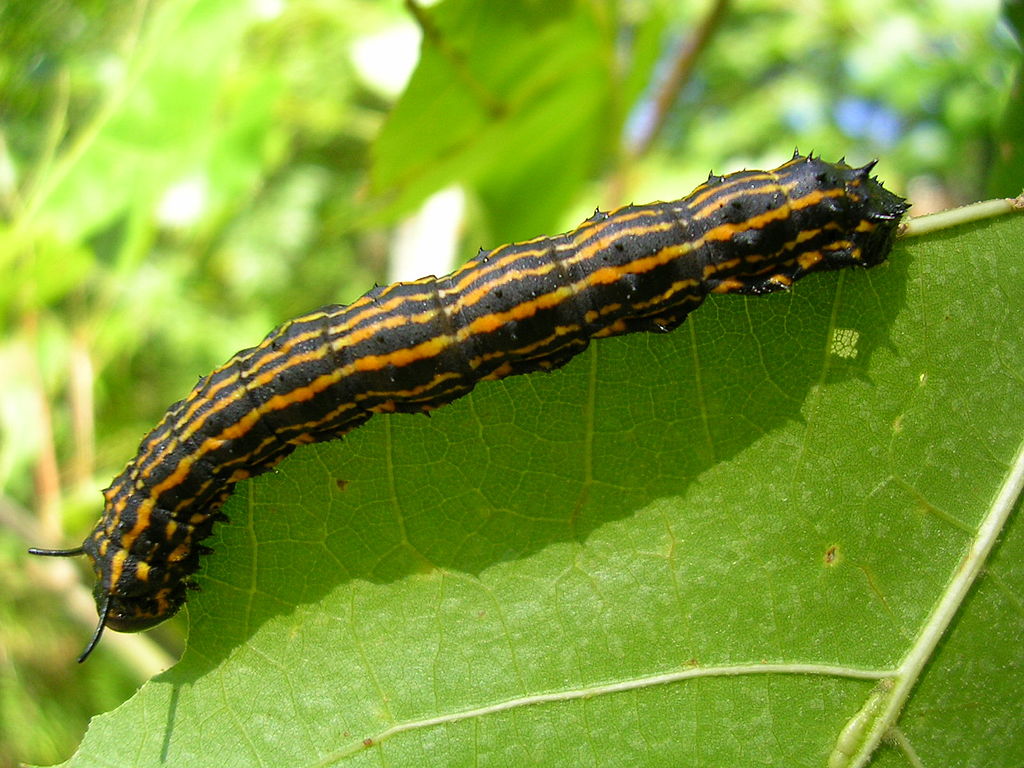Introduction
Orange-tipped oakworm moth (Anisota senatoria), also referred to as orange-striped spiny oakworm moth, is a defoliator of oak trees. It is native to North America. From late summer to early autumn, the larvae emerge from their eggs to feed on the leaves of oak trees. In the northern part of its range, populations can accumulate rapidly, resulting in periodic outbreaks. When outbreaks occur, the insect can weaken forest and shade trees, rendering them more susceptible to environmental stressors.
Distribution & Habitat
Orange-tipped oakworm moth is widespread across the Eastern United States. It is generally more abundant in the northern part of its range, particularly in deciduous forests. The insect has been reported from New England and southeastern Canada, west to the Great Lakes, and south from the Appalachian Mountains to sections of Georgia, Alabama, Mississippi, Louisiana, east Texas, and Kansas.
Hosts
Orange-tipped oakworm moth primarily infests oak trees. It has also been observed infesting birch, chinquapin, hazel, and hickory.
Description
The eggs produced by the orange-tipped oakworm moth are yellow and circular. They are deposited in clusters on the lower surfaces of oak leaves. The larvae are initially greenish yellow, with eight orange to yellow longitudinal stripes trailing down the back, and along each side of the body. When mature, the larvae turn black. They retain the characteristic orange to yellow stripes. A pair of long, slender, black spines project outward from the second segment of the thorax. Additional sets of shorter black spines are apparent along the rest of the body. The larvae can measure up to 5 cm long.
The adult females are larger than the males. The body of the female is yellow-orange to yellow-brown. The female’s forewing features a prominent white cell spot, along with a multitude of irregularly scattered black specks. The torso of the male ranges between reddish-orange and orange-brown. The male’s forewing is narrower than the female’s. It displays a small white cell spot, and a translucent white patch. The insect’s wingspan measures from 1 and 3/16 of an inch to 2 inches.
Life Cycle
Orange-tipped oakworm moth produces one generation in the north, and two generations in the south. The adults emerge from their pupal chambers from late June to early July. The females then emit a pheremone, which the males detect. The males navigate to the females and propagate, expiring soon thereafter. Mating is most frequent from late morning to early afternoon, as well as around dusk. Once the females have been fertilized, they fly to susceptible trees, where they attach up to 500 eggs in large clusters on the lower leaf surfaces.
The eggs hatch within 7 to 10 days, revealing masses of larvae. The large are gregarious when young. They will often congregate on a leaf, and feed together. The larvae are voracious feeders. They skeletonize leaves, consuming the soft tissue, while leaving the leaf veins intact. The larvae rapidly grow in size, progressing through several instars. During the late instars, the larvae disperse and continue feeding independently, or in smaller groups. Once mature, the larvae descend from the tree, and burrow a few inches into the soil, where they establish small chambers to pupate in. The larvae overwinter, and appear as adults the following summer.
Symptoms of Infestation
Dense larval populations can severely defoliate host trees. Defoliation over consecutive years can weaken trees, depleting them of their energy reserves. Due to the late period in which the larvae feed, many trees will not be profoundly impacted by the defoliation. By this point in the growing season, most healthy trees will have entered dormancy.
Larvae in their late instars will produce large pellets of frass, which can quickly accumulate, becoming an aesthetic nuisance. The larvae will often wander on sidewalks, furniture, and buildings in search of foliage to devour. With the amount of frass they excrete, this can make them problematic for pedestrians and homeowners.
Management
- Due to the innocuous nature of the adults, treatment for orange-tipped oakworm moth is seldom required.
- Maintain tree vigor through sound cultural practices.
- Ensure that trees are sufficiently watered, especially during extended periods of drought.
- Prune out dead and dying branches from trees.
- Inspect vulnerable trees for infections or infestations. If a tree contracts a disease, or is infested by another insect, promptly remedy the problem.
- Leaves that are laden with eggs can be pruned off, and disposed of.
- Apply a layer of organic mulch around the base of susceptible trees to improve the soil quality, moderate the soil temperature, and retain soil moisture.
- Avoid mechanical injuries to trees.
- Orange-tipped oakworm moth is susceptible to various diseases, as well as numerous predators and parasitoids. These natural enemies help to limit larval populations, and are often responsible for halting outbreaks in forested settings.
- Infested trees can be sprayed with Bacilus thuringiensis, a biological pesticide. Applications should be performed 1 to 2 weeks after the eggs have hatched. For this method to be effective, the larvae must be exposed to the pesticide when they are still young.
- Insecticides registered for use in control of orange-tipped oakworm moth can be utilized, although they may eradicate beneficial insects in the area as well.
Photo courtesy of Greg Dwyer CC-by-2.5


